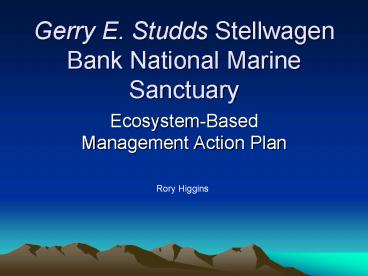Gerry E' Studds Stellwagen Bank National Marine Sanctuary - PowerPoint PPT Presentation
1 / 21
Title:
Gerry E' Studds Stellwagen Bank National Marine Sanctuary
Description:
Part of Gulf of Maine ecosystem. 638 square nautical miles, or 842 ... Cod, haddock, flounder, bluefin tuna, sharks, herring. Motivating Issues. Shipping lane ... – PowerPoint PPT presentation
Number of Views:50
Avg rating:3.0/5.0
Title: Gerry E' Studds Stellwagen Bank National Marine Sanctuary
1
Gerry E. Studds Stellwagen Bank National Marine
Sanctuary
- Ecosystem-Based Management Action Plan
Rory Higgins
2
Stellwagen Bank NMS
- Est. November 1992
- Part of Gulf of Maine ecosystem
- 638 square nautical miles, or 842 square miles
- Includes Stellwagen Bank, Tillies Bank and
southern portions of Jeffreys Ledge - 65-600 ft. deep
3
Why is it so important?
- Productive fishing ground for centuries
- Cod, haddock, flounder, bluefin tuna, sharks,
herring
- Ranked top-ten whale-watching destination
- - Million visitors annually
- - 17 marine mammal species
4
Motivating Issues
- Shipping lane
- Discharges dumping
- Fiber optic cable
- Fishing industry (440 vessels all gear)
- Abundance of recreational users
5
Goals
- Consider ecological processes both inside and
outside sanctuary. - Recognize the importance of species and habitat
diversity. - Accommodate human uses and associated benefits
within the context of conservation requirements. - Establish Ecosystem Based Management
6
Strategy 1 Establish a Research Steering
Committee
- Develop a research and monitoring plan
- determine biological reference points
- Define ecological integrity
7
Strategy 2 Establish a collaborative research
consortium
- Informal composition of academic, government,
fishermen and private interest groups - Further the knowledge of the sanctuary system
- Identify the high priority issues
- Biannual symposium, website, mailing lists
8
Strategy 3 Establish an information management
program
- Design and implement a system to integrate,
process, synthesize and analyze scientific data - Facilitate science-based management
- Public access
9
Strategy 4 Understand ecosystem structure and
function
- Measure biodiversity
- effectiveness of management
- Analyze indicator species
- Quantify nutrient loadings
- Determine dispersal rate model trajectories of
larvae
10
Strategy 4 Understand ecosystem structure and
function
- Real-time oceanographic and meteorological data
- Map the benthic habitats
- Evaluate fish movement rates
- tagging
- Effects of natural disturbances
- Storm and tidal events, etc.
11
Strategy 4 Understand ecosystem structure and
function
- Biological and physical monitoring programs
- changes, zone effectiveness
- Human use monitoring program
- Understand
- usage in and adjacent to SBNMS
- socioeconomic impacts of regulations
- spatial/temporal distribution of usage
12
Strategy 4 Understand ecosystem structure and
function
- Establish ecological research programs
- Develop a dynamic ecosystem model
- Establish an integrated monitoring system
- Real-time data at multiple depths
- Surface buoys, seafloor sensors
13
Strategy 5 Protect Ecological Integrity
- Evaluate and modify zoning schemes
- Assess minimize bycatch and discard
- Protect forage species (herring, squid, mackerel,
sand eels) - Ban exploitation of sand eels
14
Strategy 6 Evaluate the need and feasibility for
modifying the sanctuary boundary
- Jeffreys Ledge extension?
- Ecology and socioeconomics of Jeffreys Ledge
- Ecological relationship between Jeffreys Ledge
and SBNMS
15
Status
- Nov. 2001-Jan. 2002Issue Identification
- Winter 2003Issue Prioritization
- Spring 2003Working Group Structure and Formation
- Summer/Fall 2003 Work Plan Development
- Winter-Summer 2004Action Plan Development
- Fall 2004 SAC Action Plan Review and
Recommendations - Winter-Summer 2005Draft Management Plan
Preparation - Summer 2005 Draft Management Plan Published for
Public Comment - Summer/Fall 2006Final Management Plan Preparation
16
Stakeholder Involvement
- Steering committee, Research Consortium, Research
Programs, public access to data - SBNMS staff, NEFMC, NOAA NEFSC, academia, fishing
industry, conservation organizations, public,
USCG, MFP, FISHER
17
Policies
- National Marine Sanctuaries Act
- Authority to conserve and manage marine areas
and activities affecting them. - Maintain the natural biological communities.
- Protect, and where appropriate, restore and
enhance natural habitats, populations and
ecological processes. - Create models of, and incentives for, ways to
conserve and manage these areas
18
Ecological Values
- Comprehensive ecosystem protection
- Ecological processes in and out of sanctuary
boundaries - Importance of species and habitat diversity
- Recognize uncertainty, manage adaptively
- Achieve environmental sustainability
19
Socioeconomic Values
- Accommodate human uses and associated benefits
- Public accessibility
- Reduce habitat impacts by users
- Public access to data
- Human use monitoring program
- Determine impacts of regulations
20
Monitoring
- Adaptive management, develop models
- Biological and Physical monitoring programs
- Understand changes in the natural systems
- Determine effectiveness of any zones
- Human use monitoring program
- Vessel monitoring devices, refined vessel trip
reports, call in system
21
Why it will be effective?
- Stakeholder involvement
- Adaptive management
- Accepting uncertainty
- Comprehensive monitoring programs
- Human uses ecological integrity
Questions?































